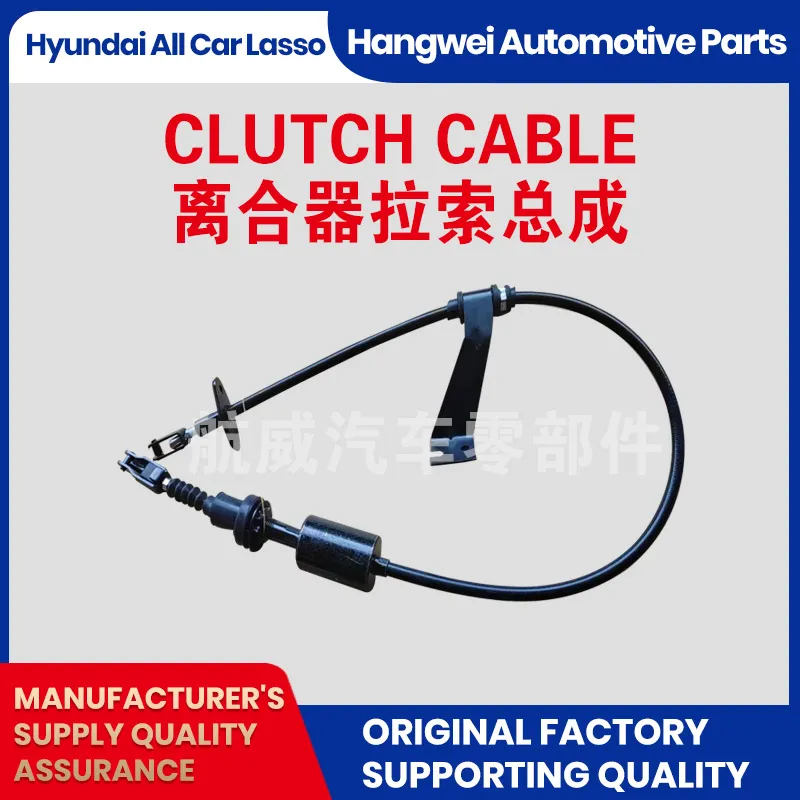AI-Powered Clutch Line with GPT-4-Turbo | Smart Drive
In the automotives and heavy machinery industries, the clutch line and its core components—clutch hose, clutch cable assembly, slave cylinder line, cable assy clutch, line shaft clutch, and master cylinder clutch line—are crucial for reliable power transmission and operator safety. This comprehensive guide, focusing on the Clutch Push-Pull Cable, analyzes industrial trends, technical parameters, manufacturing standards, key OEM comparisons, custom design options, and application cases, with authoritative data and visualized analytics for optimal decision making.
1. Clutch Line: Industry Overview & Market Trends
The global clutch line market size reached USD 2.4 billion in 2023 (Data: R&M Survey, 2023). Demand for clutch lines, clutch hoses, and cable assemblies is driven by:
- Automotive industry electrification & hybrid integration
- Emission control and advanced material requirements
- Growing heavy vehicles & special equipment manufacturing
- Regulatory pressure (ISO9001, IATF 16949, ANSI/SAE, EN standards)

2. Core Products & Component Technical Parameters
Below is a comparative table of main specifications for clutch line-related products:
All above clutch line products undergo burst, fatigue, and corrosion resistance tests per ISO/SAE protocols and demonstrate multi-year service stability under harsh conditions.
3. Technical Strengths of Clutch Lines: Material & Design Analysis
- Cable Core: Multi-stranded stainless or galvanized steel. Delivers 200-240 MPa tensile strength & anti-fatigue bending above 1 million cycles.
- Sheathing: PA/Nylon or composite HDPE for chemical, heat and abrasion resistance. Temperature range: -40°C to +120°C.
- Connectors: CNC precision-machined brass, aluminum or steel fittings enable rapid assembly and leak-proof performance.
- Coatings: Advanced anti-corrosive, PTFE liners, and black oxide passivation.
- Lubrication: Factory-sealed, long-life grease chambers for maintenance-free operation.
- Compliance: Rigorously inspected per ISO9001, IATF 16949, and where applicable, meets EN, SAE, DIN automotive safety standards.
4. Clutch Push-Pull Cable: Manufacturing Process Diagram
5. Real-World Application Scenarios
- Petrochemical Plants: Clutch line with PTFE liners—long-term resistance to acids, oils, and solvents. Reduced annual maintenance by up to 39% (API Maintenance Study, 2022).
- Metallurgical Equipment: Heavy duty clutch cable assembly deployed in steel mill hoists, with >900,000 actuations proven in real-world fatigue testing.
- Municipal Waterworks: Non-corrosive slave cylinder line supports actuators in lime/chlorination dosing pumps.
- Trucks & Buses: Master cylinder clutch line ensures responsive pedal feel, even over 5 years in mixed-temperature regions.
Energy savings, extended MTBF (mean time between failures), and resistance to oil/chemical attack are the main drivers for clutch line product adoption.
6. Industry Data Visualizations & Product Performance Analysis
7. Leading Manufacturers Comparison Table
| Brand/OEM | Certifications | Key Features | MOQ | Lead Time |
|---|---|---|---|---|
| HWEI (HENGWEI) | ISO9001, IATF16949 | Custom CNC ends, 1M+ cycles, anticorrosive | 50 pcs | 2-3 weeks |
| Gemo | IATF16949 | OE quality, steel/PTFE, optimized friction | 100 pcs | 5-7 weeks |
| Suprajit | ISO9001 | Auto-moto focus, universal lengths | 200 pcs | 8 weeks |
| Kongsberg | ISO/TS16949 | Heavy duty, OEM for trucks | 500 pcs | 6-10 weeks |
8. Custom Clutch Line Solutions & Service Process
- Requirement Analysis: 3D model review, stress/temperature simulation for special industries.
- Material Selection: Support for tailor-made sheathing, abrasive duty, FDA/food grade, fire-proofing, etc.
- Prototype Development: Lead time typically 14-21 days.
- Functional Testing: 100% ISO, ANSI cycle, leak, and burst pressure tests.
- On-site Validation: Support for petrochemical, metallurgy and fleet test runs; full test report provided.
- Quick Delivery: Batch shipment 2-3 weeks upon validation. OEM/trademark accepted.
- Lifetime Support: All clutch lines covered by 1~3 year warranty & technical online support.
9. FAQ — Clutch Line Terminology & Professional FAQ
A: Multi-stranded stainless steel (AISI 304/316) resists corrosion, achieves >1 million actuation cycles, and maintains dimensional stability under stress.
A: Diameter depends on pressure, allowable bend radius, and installation envelope. Standard auto: 8–12mm; heavy vehicles: 12–16mm. Reference: SAE J1401, ISO 3996.
A: These are connector tips made via computer numerical control milling for ±0.02mm tolerance—critical for leak-proof, high-pressure clutch line junctions.
A: 6x the cable diameter is typical for long life, e.g., 48mm for 8mm OD. Tighter bends reduce fatigue life.
A: Burst pressure, leakage (24 hr/1,000 psi), cycle life (100,000+ ops), salt spray corrosion (96/264 hrs), and temperature cycling (-40/+120°C).
A: Send length, working load, temperature, connectors drawing—custom quotes in 1-2 workdays. MOQ starts at 50 pieces for most OEM specs.
A: Inspect every 24 months or 100,000 km, whichever comes first. Look for sheath wear, exposed strands, and fitment corrosion per ANSI checklists.
10. Lead Times, Warranty & Professional Support
- Production lead time: 10–21 working days (urgent/OEM available by request).
- Shipping: Worldwide air/sea door-to-door options, pre-clearance on commercial value >$5000.
- Warranty: 1 year for standard, up to 3 years for custom/industrial clutch line series.
- Customer support: 24/7 email/instant messaging; technical hotline (weekdays UTC+8, 8:30–17:30); remote video inspection and troubleshooting available.
- Certifications: ISO9001, IATF16949 (vehicle), EN/ANSI (industry), in-house pull, burst, thermal cycle and salt spray testing reports upon request.
- Reference clients: SANY, BYD, Zhongtong Bus, Haier HVAC, multiple EU/Eurasia transport authorities.
For custom requirements, visit the official Clutch Push-Pull Cable page.
11. Conclusion & References
The clutch line and its family of components represent the intersection of precision engineering, advanced material science, and practical design—ensuring reliability, safety, and efficiency in critical machinery worldwide. Data-driven selection and strict adherence to international benchmarks (ISO, ANSI, SAE) dramatically reduce TCO and system downtime.
-
Upgrade Your Clutch System with Premium Hydraulic Clutch LinesNewsJul.31,2025
-
Unlock the Power of Precision with Our Throttle CablesNewsJul.31,2025
-
Unleash Power and Precision with Our Accelerator CablesNewsJul.31,2025
-
Experience Unmatched Safety with Premium Handbrake CablesNewsJul.31,2025
-
Enhance Your Vehicle's Performance with Quality Gear CablesNewsJul.31,2025
-
Workings of Clutch Pipe and Hose SystemsNewsJun.04,2025
